



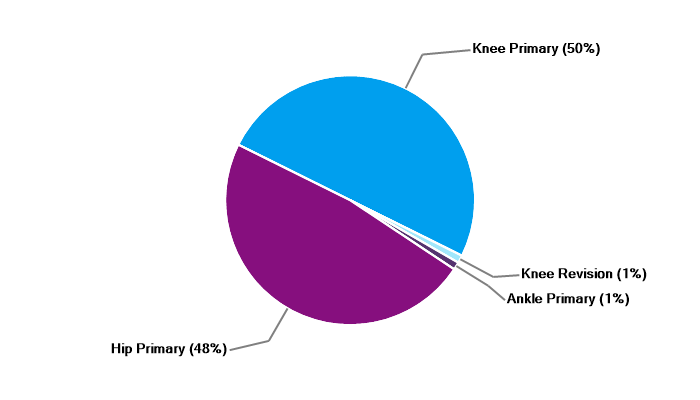
| Operation Type | Operation Subcategory | Procedures Recorded for this Hospital | National Average |
|---|---|---|---|
| Hip Primary | - | 468 | 329 |
| Hip Revision | - | Fewer Than 5 | 22 |
| Knee Primary | Patello-Femoral Replacement | Fewer Than 5 | 5 |
| Knee Primary | Total knee replacement | 412 | 280 |
| Knee Primary | Unicondylar Knee Replacement | 57 | 52 |
| Knee Revision | - | 9 | 16 |
| Ankle Primary | - | 16 | 6 |
| Ankle Revision | - | Fewer Than 5 | 2 |
| Shoulder Primary | - | 6 | 24 |
| Total | 968+ | 736 |

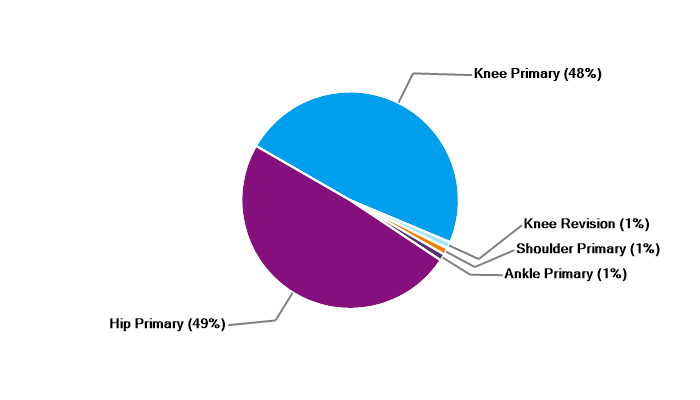
| Operation Type | Operation Subcategory | Procedures Recorded for this Hospital | National Average |
|---|---|---|---|
| Hip Primary | - | 1243 | 832 |
| Hip Revision | - | Fewer Than 5 | 58 |
| Knee Primary | Patello-Femoral Replacement | 8 | 11 |
| Knee Primary | Total knee replacement | 1018 | 703 |
| Knee Primary | Unicondylar Knee Replacement | 166 | 129 |
| Knee Revision | - | 26 | 46 |
| Ankle Primary | - | 35 | 14 |
| Ankle Revision | - | Fewer Than 5 | 5 |
| Elbow Primary | - | Fewer Than 5 | 13 |
| Shoulder Primary | - | 9 | 62 |
| Total | 2505+ | 1873 |


This information display shows you how this hospital compares to the national rates for a range of patient improvement and outcomes measures used to demonstrate quality in joint replacement surgery. Against each measure you will be able to see whether this hospital is performing better than expected, within the expected range or worse than expected for this type of surgery. This hospital is represented on the chart by the black marker ( ).
).
It is important to note that the types of patients a hospital treats and the procedures it carries out can explain variation in patient outcomes after surgery. Please click on the “How to interpret this chart” button for further information.
Patient improvement, featured in this chart, looks at three measures of patient-reported outcomes that are routinely assessed following hip/knee replacement in England. This information is not currently collected in Wales, Northern Ireland, the Isle of Man, Guernsey or the independent sector and as a result, no data is available to display.
The measures are referred to using their technical names 'Oxford hip/knee score', 'EQ-5D' and 'EQ-VAS' click here for a non-technical introduction to these.
Data for 1 April 2023 - 31 March 2024
 to find out more about the quality measure and its source data
to find out more about the quality measure and its source data
| Patient Reported Improvement Measure | This Trust | Patient Records Analysed | Trust Avg Health Gain | National Avg Health Gain | |
|---|---|---|---|---|---|
| Oxford hip Score | No Data Available | - | - |
| |
| EQ-5D | No Data Available | - | - |
| |
| EQ-VAS | No Data Available | - | - |
|
Patient outcomes, featured in this second chart below, looks at mortality and revision. Please click on the “How to interpret this chart” button for further information including additional notes on factors that may affect the results shown including whether the hospital is providing a full and accurate submission of first-time joint replacement and revision operation data to the NJR.
Data for May 2013 - May 2023
 to find out more about the quality measure and its source data
to find out more about the quality measure and its source data
| Patient Outcomes Quality Measure | This Hospital | Patient Records Analysed | This Hospital Ratio | National Ratio | |
|---|---|---|---|---|---|
| 90 Day Mortality: Operations May18-May23 |  As Expected As Expected | 1549 | 1.14 | 1.00 |
|
| Revision Rate: Operations May13-May23 |  As Expected As Expected | 3173 | 0.64 | 1.00 |
|
| Revision Rate: Operations May18-May23 |  As Expected As Expected | 1554 | 0.81 | 1.00 |
|

This information display shows overall characteristics for first-time hip replacement patients treated at this hospital between 1 April 2003 and 31 March 2024. Against each characteristic you will be able to see whether this hospital has treated a greater or fewer number of patients of a particular type. This hospital is represented on the chart by the black marker ( ).
).
The types of patients a hospital treats can explain variation in patient outcomes after surgery. Please click on the “How to interpret this chart” button for further information.
For hospitals in England and Wales, the NJR has collected information since 2003. For Northern Ireland since 2013, for the Isle of Man since 2015 and for Guernsey since 2019.Data for 1 April 2003 - 31 March 2024
 to find out more about the quality measure and its source data
to find out more about the quality measure and its source data
| Percentage Of Patients Who Were: | This Hospital | National Average | |
|---|---|---|---|
| Male | 46% | 40% |
|
| Under 60 years of age | 30% | 21% |
|
| Severely Obese (BMI of 35 or greater) | 10% | 13% |
|
| At higher risk of medical problems before or after Surgery (ASA 3+) | 2% | 19% |
|
| Diagnosed with conditions other than Osteoarthritis | 5% | 12% |
|

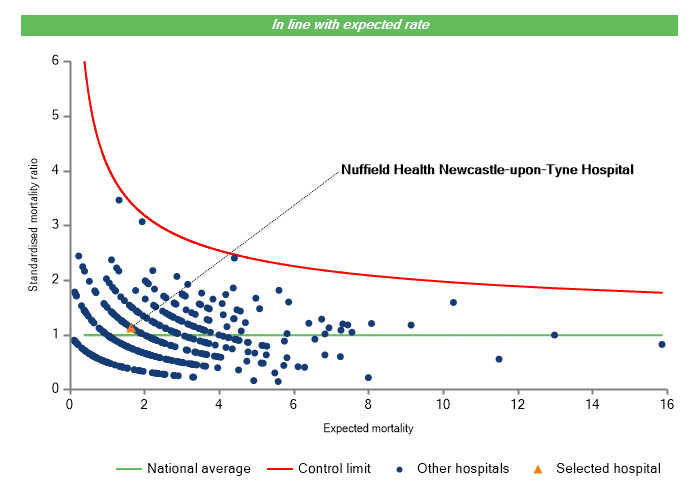
What does this mean?
This shows 90-day mortality following hip surgery for this hospital, based on the type of patients this hospital has seen.
The hospital you are reviewing is highlighted as an orange triangle. Progression along the horizontal axis (x axis) means that the hospital has done more cases and/or cases at a higher mortality risk such as older patients. Progression along the vertical axis (y axis) means the hospital has had more deaths.
The vertical axis figures are presented as a standardised mortality ratio. This means the values do not represent percentages of patients who have died, but they represent the proportion of deaths compared to the national average. The data is also ‘risk adjusted’ to take account of the fact that different hospitals may operate on more higher-risk or lower-risk patients e.g. because of demographics in the patient population they work with.
The overall 90-day mortality rate following primary hip replacement surgery is approximately 0.24%.

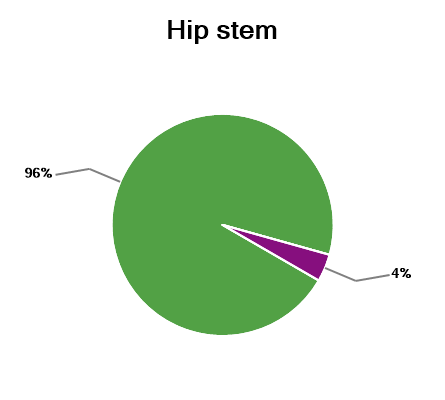
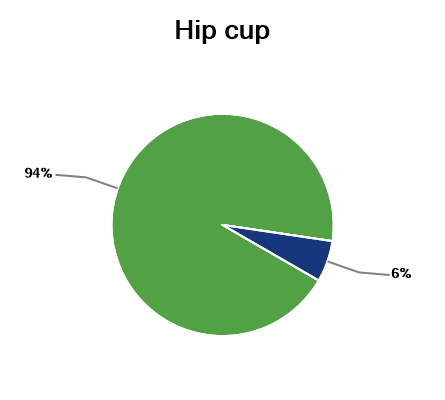


This information display shows you how this hospital compares to the national rates for a range of patient improvement and outcomes measures used to demonstrate quality in joint replacement surgery. Against each measure you will be able to see whether this hospital is performing better than expected, within the expected range or worse than expected for this type of surgery. This hospital is represented on the chart by the black marker ( ).
).
It is important to note that the types of patients a hospital treats and the procedures it carries out can explain variation in patient outcomes after surgery. Please click on the “How to interpret this chart” button for further information.
Patient improvement, featured in this chart, looks at three measures of patient-reported outcomes that are routinely assessed following hip/knee replacement in England. This information is not currently collected in Wales, Northern Ireland, the Isle of Man, Guernsey or the independent sector and as a result, no data is available to display.
The measures are referred to using their technical names 'Oxford hip/knee score', 'EQ-5D' and 'EQ-VAS' click here for a non-technical introduction to these.
Data for 1 April 2023 - 31 March 2024
 to find out more about the quality measure and its source data
to find out more about the quality measure and its source data
| Patient Reported Improvement Measure | This Trust | Patient Records Analysed | Trust Avg Health Gain | National Avg Health Gain | |
|---|---|---|---|---|---|
| Oxford knee Score | No Data Available | - | - |
| |
| EQ-5D | No Data Available | - | - |
| |
| EQ-VAS | No Data Available | - | - |
|
Patient outcomes, featured in this second chart below, looks at mortality and revision. Please click on the “How to interpret this chart” button for further information including additional notes on factors that may affect the results shown including whether the hospital is providing a full and accurate submission of first-time joint replacement and revision operation data to the NJR.
Data for May 2013 - May 2023
 to find out more about the quality measure and its source data
to find out more about the quality measure and its source data
| Patient Outcomes Quality Measure | This Hospital | Patient Records Analysed | This Hospital Ratio | National Ratio | |
|---|---|---|---|---|---|
| 90 Day Mortality: Operations May18-May23 |  As Expected As Expected | 1582 | 0.70 | 1.00 |
|
| Revision Rate All Knees: Operations May13-May23 |  As Expected As Expected | 3331 | 0.86 | 1.00 |
|
| Revision Rate Total Knee replacement: Operations May13-May23 |  As Expected As Expected | 3138 | 0.95 | 1.00 |
|
| Revision Rate Unicondylar Knees: Operations May13-May23 |  As Expected As Expected | 182 | 0.96 | 1.00 |
|
| Revision Rate All Knees: Operations May18-May23 |  As Expected As Expected | 1609 | 0.95 | 1.00 |
|

This information display shows overall characteristics for first-time knee replacement patients treated at this hospital between 1 April 2003 and 31 March 2024. Against each characteristic you will be able to see whether this hospital has treated a greater or fewer number of patients of a particular type. This hospital is represented on the chart by the black marker ( ).
).
The types of patients a hospital treats can explain variation in patient outcomes after surgery.
For hospitals in England and Wales, the NJR has collected information since 2003. For Northern Ireland since 2013, for the Isle of Man since 2015 and for Guernsey since 2019.
Please click on the “How to interpret this chart” button for further information.
Data for 1 April 2003 - 31 March 2024
 to find out more about the quality measure and its source data
to find out more about the quality measure and its source data
| Percentage Of Patients Who Were: | This Hospital | National Average | |
|---|---|---|---|
| Male | 48% | 44% |
|
| Under 60 years of age | 25% | 17% |
|
| Severely Obese (BMI of 35 or greater) | 20% | 23% |
|
| At higher risk of medical problems before or after Surgery (ASA 3+) | 2% | 17% |
|
| Diagnosed with conditions other than Osteoarthritis | 4% | 4% |
|

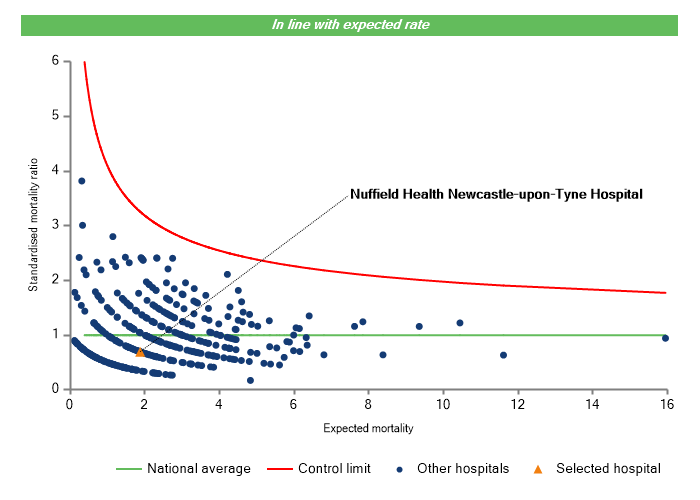
What does this mean?
This shows 90-day mortality following knee surgery for this hospital, based on the type of patients this hospital has seen.
The hospital you are reviewing is highlighted as an orange triangle. Progression along the horizontal axis (x axis) means that the hospital has done more cases and/or cases at a higher mortality risk such as older patients. Progression along the vertical axis (y axis) means the hospital has had more deaths.
The vertical axis figures are presented as a standardised mortality ratio. This means the values do not represent percentages of patients who have died, but they represent the proportion of deaths compared to the national average. The data is also ‘risk adjusted’ to take account of the fact that different hospitals may operate on more higher-risk or lower-risk patients e.g. because of demographics in the patient population they work with.
The overall 90-day mortality rate following primary knee replacement surgery is approximately 0.21%.


This information display shows overall characteristics for first-time ankle replacement patients treated at this hospital between 1 April 2010 and 31 March 2024. Against each characteristic you will be able to see whether this hospital has treated a greater or fewer number of patients of a particular type. This hospital is represented on the chart by the black marker ( ).
).
The types of patients a hospital treats can explain variation in patient outcomes after surgery.
Note: Data submission for Northern Ireland hospitals started in February 2013, for the Isle of Man in July 2015 and for Guernsey in November 2019.
Please click on the “How to interpret this chart” button for further information.
Data for 1 April 2010 - 31 March 2024
 to find out more about the quality measure and its source data
to find out more about the quality measure and its source data
| Percentage Of Patients Who Were: | This Hospital | National Average | |
|---|---|---|---|
| Male | 66% | 60% |
|
| Under 60 years of age | 37% | 20% |
|
| Severely Obese (BMI of 35 or greater) | 17% | 14% |
|
| At higher risk of medical problems before or after Surgery (ASA 3+) | 3% | 18% |
|
| Diagnosed with conditions other than Osteoarthritis | 1% | 10% |
|


This information display shows overall characteristics for first-time shoulder replacement patients treated at this hospital between 1 April 2012 and 31 March 2024. Against each characteristic you will be able to see whether this hospital has treated a greater or fewer number of patients of a particular type. This hospital is represented on the chart by the black marker ( ).
).
The types of patients a hospital treats can explain variation in patient outcomes after surgery.
Note: Data submission for Northern Ireland hospitals started in February 2013, for the Isle of Man in July 2015 and for Guernsey in November 2019.
Note: BMI data submission for Elbows started in June 2018.
Please click on the How to interpret this chart button for further information.
Data for 1 April 2012 - 31 March 2024
 to find out more about the quality measure and its source data
to find out more about the quality measure and its source data
| Percentage Of Patients Who Were: | This Hospital | National Average | |
|---|---|---|---|
| Male | 21% | 30% |
|
| Under 60 years of age | 6% | 11% |
|
| Severely Obese (BMI of 35 or greater) | 44% | 18% |
|
| At higher risk of medical problems before or after Surgery (ASA 3+) | 6% | 32% |
|
| Diagnosed with conditions other than Osteoarthritis | 15% | 48% |
|

This information display shows whether this hospital is submitting all the data they should to the NJR (compliance), whether those records have corresponding patient details (patient consent) and whether the records have a valid NHS or national patient number. This is important so that the NJR can measure how long implants last and look at other areas of surgical performance.
The display also shows a result for data entry delay. This indicates whether the hospital is submitting their information in a timely way. This is important so that the NJR can report an accurate and full picture of performance to hospitals, the surgeons who work there as well as to patients and the public.
This hospital is represented on the chart by the black marker ( ). Please click on the “How to interpret this chart” button for further information.
). Please click on the “How to interpret this chart” button for further information.
Data for 1 April 2023 - 31 March 2024
 to find out more about the quality measure and its source data
to find out more about the quality measure and its source data
| Quality Measure | This Hospital | National Expected | ||
|---|---|---|---|---|
| Compliance (for the Trust) | No Data Available | - | - |
|
| Revision Compliance (for the Trust) | No Data Available | - | - |
|
| Consent |  Better Than Expected Better Than Expected | 93.7% | 90.0% |
|
| Valid NHS number |  Better Than Expected Better Than Expected | 96.2% | 95.0% |
|
| Time taken to enter data |  As Expected As Expected | 22 Days | 30 Days |
|